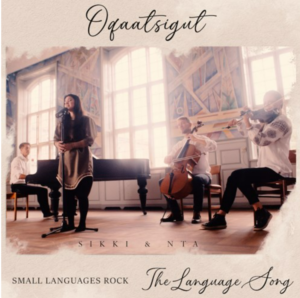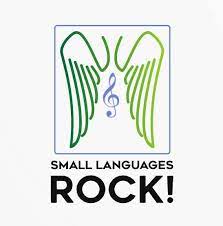Language is something all humans share, and perhaps, since we all have it, we sometimes take it for granted. During my years as a researcher I have spoken with many people who themselves, their parents, or grandparents have lost their language. A language loss is often experienced as a trauma and simultaneously as a loss of one’s culture, identity, and roots. A language is but one attribute of a person’s individual identity and group identity. This attribute very often coincides with other attributes – traditions, heritage, clothing, food and more. When a language disappears, due to colonisation or other types of power manifestations, many other of the groups’ attributes disappear.

About half of today’s languages are at risk of dying out and many of those languages are indigenous languages in Europe, America, Africa, and Asia. Luckily, Greenlandic, or Kalaallisut, is not one of them. Even though the language is not present in all domains of life in Greenland, Greenlandic is still the majority language of the Inuit in Greenland. For instance, for higher education you need to switch to another language. Additionally, and most importantly, the Greenlandic language is transmitted from the parents’ generation to the children’s generation, thus ensuring its survival.
Some people ask me: Isn’t the fact that so many languages disappear just a natural result of modernisation, as well as globalisation? And moreover: Wouldn’t it be better if all human beings just spoke one, single language?
First of all, we all have the right to decide for ourselves which language to talk. Linguistic rights (the right to choose which language one wishes to use in the private or in the public sphere) are part of the international human rights included in the Universal Declaration of Human Rights in 1948. Moreover, when we look at the history of language loss it becomes clear that in most cases people did not voluntarily decide to give up their language. Rather, language loss is usually caused due to one group of people overpowering another one and imposing its culture and language on it. When the three Baltic nations became independent, it became an important task for all three of them to upgrade their languages. Today we have Estonian, Latvian, and Lithuanian.
Lutheranism and the French revolution opened the door for language diversity in Europe for nation states and for the translation of the bible to small national languages, rather than reading it in Latin or Old Slavonic. Hereby, many European nations could ‘upgrade’ their languages to turn them into literary and scholarly languages used in all walks of life. Thus also Scandinavia acquired new literary languages – first Danish and Swedish, but in the 19th century also Norwegian, Finnish, Icelandic, and Faroese as a part of a national and political revitalisation. However, for other minorities in Scandinavia, such as the Sami, the fight for the native language was much harder. Many Samis in Norway, Sweden, and Finland have lost their languages due to harsh assimilation policies and due to a strong discriminatory policy, through which some speakers began judging their own language as a bad language that is not worth using, and likewise towards their culture. Sami began to be introduced in schools only in the 1970s.
However, compared to other colonized languages, Greenlandic has been lucky since the language was never forbidden by the Danish authorities. The fact that Greenland is an island far from Denmark probably contributed to its protection from extinction. But in the 1950s some advocated a linguistic and cultural assimilation of the Greenlanders. A Danish minister in the 1950s even suggested that the Greenlandic language should be simply abolished. As an attempt, Danish was introduced into the three grades of the elementary school in Greenland. However, some years later Greenlandic was reintroduced there. Some Inuit families decided to switch to Danish, as they were told that Danish was the language of the future. And indeed – this is a concept, which has been adopted by many communities from the powerful part, i.e. that the old, small, native tongue has no place in the modern world. Being the first generation of native Hebrew speakers in my family, I can tell you that these ideas are baseless – my people managed to revitalise my ancient Hebrew language from the ashes after 2000 years, during which it was mostly used for religious purposes. I have never felt like I had grown up with a language that was artificially brought back to life, or with a language that lacks words for the modern world. Today Hebrew is spoken by more than 10 million people and can be used in all walks of life.

And what can we treat as natural and unnatural? Is it natural that we should all be speaking American English in 30 or 50 years, or that our language should contain 70% of English loanwords? No, there is nothing natural about it. It is up to every language community to shape its own linguistic reality as it wishes. Moreover, today we know that our brains are capable of containing several languages at the same time. Hence, native language skills are not a hinder for mastering more languages. On the other hand, multilingualism is enriching!
Greenland is an excellent example of a rather small community who decided to preserve its own culture, language, and identity. With linguistic diversity we also have cultural and ideological diversity. By acquiring knowledge about the different languages we also acquire knowledge and respect towards other groups, their cultures, as well other ways of approaching reality.
On the 8th of November 2023 a new beautiful and unique song was released: Oqaatsigut/The Language Song. The song is a tribute to the Greenlandic language, Kalaallisut, and also to every indigenous or threatened language in the world. I am deeply grateful to everyone who has made the production of this song possible: NAPA, the Greenlandic Culture Fund, the non-profit project Small Languages Rock, my co-authors Malik Chemnitz and Christine Tongue, our fantastic singer Sikki and the amazing musicians Torbjørn, Natalia and Andreas.
The song is published in both a Greenlandic version and an English version. Listen to both here (the first video is the Greenlandic version and the second video is the English version).
This post is based on Yair Sapir’s speech at the reception and premiere of Oquutsigut/The Language Song on November 8th 2023.
Cover photo: Mathias De Melo Lundegaard
Yair Sapir is a songwriter and associate professor of Swedish language in Kristianstad. He is part of Small Languages Rock, the non-profit project behind Oqaatsigut/The Language Song.







